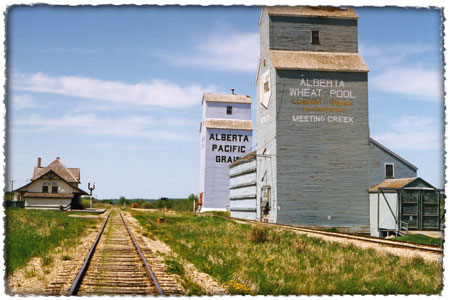 nationalism as a whole because of its association with the early conflicts of settling and 'civilizing' Western Canada. In beginning to interpret its importance as an official Heritage Site, a brief understanding of its historical time line is necessary followed by a look at the proposals presented in favour of its creation.
nationalism as a whole because of its association with the early conflicts of settling and 'civilizing' Western Canada. In beginning to interpret its importance as an official Heritage Site, a brief understanding of its historical time line is necessary followed by a look at the proposals presented in favour of its creation. Battleford was established as a military barrack for the North West Mounted Police and the first capital of the former Northwest
 Territories in 1876. Prior to confederation, the region of the prairies was owned by the Hudson's Bay Company and few non-native settlements had been established west of Manitoba boarders. The Canadian Dominion was pushing for control over the nation from Atlantic to Pacific and the Northwest Territories stood in the way as a land which required registered settlement and good governing. In the eyes of the elite, a fort for the NWMP suited best for initiating the push of the Frontier westward. This action was performed in most part in hopes to break the 'savagery' of the existing Native tribes and peacefully incorporate them into civilized society. In 1885, mounting fears of physical conflict had put both the Métis/Native peoples and the NWMP settlements into a relationship with a thin breaking point. Members of the local tribes had
Territories in 1876. Prior to confederation, the region of the prairies was owned by the Hudson's Bay Company and few non-native settlements had been established west of Manitoba boarders. The Canadian Dominion was pushing for control over the nation from Atlantic to Pacific and the Northwest Territories stood in the way as a land which required registered settlement and good governing. In the eyes of the elite, a fort for the NWMP suited best for initiating the push of the Frontier westward. This action was performed in most part in hopes to break the 'savagery' of the existing Native tribes and peacefully incorporate them into civilized society. In 1885, mounting fears of physical conflict had put both the Métis/Native peoples and the NWMP settlements into a relationship with a thin breaking point. Members of the local tribes had  gathered under Chief Poundmaker to confront the local Native Agent at the fort in order to express their concerns for the intrusion of the Federal government. Simultaneously, the police stationed at the fort had received several escaped captives of a travelling family bringing news of the murder of other family members by a Cree tribe. With tensions already high, Battleford opened as a refuge for settlers and stood ready in expectance of an attack from the arriving tribe members. With tensions high conflict broke out at nearby Cut Knife Hill, which resulted in the trial and execution of eight native prisoners back in Battleford.
gathered under Chief Poundmaker to confront the local Native Agent at the fort in order to express their concerns for the intrusion of the Federal government. Simultaneously, the police stationed at the fort had received several escaped captives of a travelling family bringing news of the murder of other family members by a Cree tribe. With tensions already high, Battleford opened as a refuge for settlers and stood ready in expectance of an attack from the arriving tribe members. With tensions high conflict broke out at nearby Cut Knife Hill, which resulted in the trial and execution of eight native prisoners back in Battleford. The 'metropolitan' standpoint, which Walter Hildebrandt opposes in his work Views from Fort Battleford, is one which is based on the glorification of NWMP and western settlement. The presentations and information on display at the Heritage site today attempt to enforce equal attention to the viewpoints of both parties in the face of the conflict which broke out during the Rebellions/Resistances of that year. The period from 1885 until the forts closure in 1924 represents a notable turning-point in federal government action. During this period the federal government saw the First Nations and Métis effectively as obstacles to the grand vision of confederation and referenced the Northwest Rebellions as a need to further assimilate or seclude their populations. Initially, the NWMP were recommended to enforce the terms of the Indian Act more efficiently. Significant amendments were made to restrict religious ceremonies such as potlatches and outline actions for removal of reserve land in 1885 and 1905 respectively to insure safety for arriving immigrants.
Upon the closure of the operational fort in 1924, the site was designated with historical recognition by the Historic Sites and Monuments Board of Canada (HSMBC) and commemorated with the iconic Heritage Site
 bronze plaque. The story portrayed during its opening years focused mainly on the metropolitan depiction common of the time period, holding little truth for First Nation representations. In the late 1940s, significant demand led Campbell Innes and several other scholars to insist that the HSMBC incorporate the First Nations voice into the historic site. Today, the displays and tours are geared to present a truthful representation of the events specific to Battleford in order to allow visitors a chance to relive the experiences as they had happened many years ago. Furthermore, it does not stand alone as the only educational institution in the region, sharing the town with the Western Development Museum and several other tourist information attractions. Together these establishments hope to educate the public by creating meaningful relationships with the past and encouraging nationalism.
bronze plaque. The story portrayed during its opening years focused mainly on the metropolitan depiction common of the time period, holding little truth for First Nation representations. In the late 1940s, significant demand led Campbell Innes and several other scholars to insist that the HSMBC incorporate the First Nations voice into the historic site. Today, the displays and tours are geared to present a truthful representation of the events specific to Battleford in order to allow visitors a chance to relive the experiences as they had happened many years ago. Furthermore, it does not stand alone as the only educational institution in the region, sharing the town with the Western Development Museum and several other tourist information attractions. Together these establishments hope to educate the public by creating meaningful relationships with the past and encouraging nationalism. 




















No comments:
Post a Comment